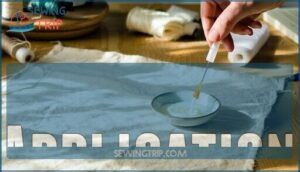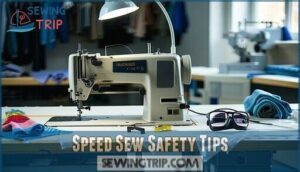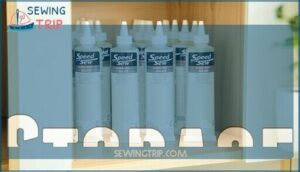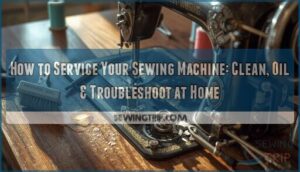This site is supported by our readers. We may earn a commission, at no cost to you, if you purchase through links.
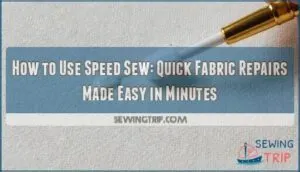
First, clean your fabric surface thoroughly. Squeeze Speed Sew onto a small dish, then use a cotton swab or toothpick as your applicator.
Apply a thin, even layer to the tear or hem—think of it like spreading butter on toast, but thinner. If you mess up, don’t panic; you can remove wet glue with water.
Let it air dry for several minutes without ironing, as heat can weaken the bond. The key is patience and precision.
There’s more to getting professional-looking results than just the basic application technique, which requires professional-looking results.
Table Of Contents
Key Takeaways
- You’ll get the best results by cleaning your fabric thoroughly first, then applying Speed Sew in thin, even layers using a cotton swab or toothpick as your applicator.
- Don’t iron immediately after application since heat weakens the bond – instead, let it air dry for several minutes and wait 24 hours before washing for maximum durability.
- Work in well-ventilated areas and keep Speed Sew away from heat sources since it’s flammable, and wear gloves if you’re sensitive to latex to avoid allergic reactions.
- You can expect permanent, flexible bonds that outlast traditional stitching on medium-weight fabrics like cotton and denim, but it won’t handle heavy-duty stress as well as needle and thread.
What is Speed Sew?
Speed Sew is a liquid fabric adhesive that’s been trusted for over 50 years to create bonds stronger than traditional stitches, making it your go-to solution when you need quick repairs without threading a needle.
You’ll find this clear-drying, flexible glue works on most medium-weight fabrics like cotton, denim, and canvas, giving you professional results in just minutes instead of hours spent hand-sewing.
Overview
Meet your fabric repair game-changer: SpeedSew transforms torn clothing into perfect patches without threading a single needle.
**Lightning-fast fabric fixes that outlast traditional stitching—no needle skills required.
This liquid latex formula creates invisible bonds that actually outlast traditional stitching, making it perfect for DIY projects and emergency fixes. The device is also user-friendly, with features like easy battery installation.
Here’s what makes this product description stand out:
- Lightning-fast repairs – Fix tears in under a minute instead of spending hours with needle and thread
- Bulletproof bonding strength – Creates flexible, wash-resistant bonds that move with your fabric naturally
- Beginner-friendly ease of use – No sewing skills required, just brush and press for professional results
Whether you’re tackling children’s torn jeans or delicate upholstery, this speed sew tutorial essential handles diverse fabric compatibility challenges effortlessly.
Ingredients
Speed Sew’s chemical composition centers on natural latex as its primary ingredient, delivering that signature flexibility you need for lasting repairs.
This natural rubber base works alongside water as a solvent, plus carefully selected additives like preservatives and stabilizers that enhance performance.
While some fabric adhesives rely on synthetic alternatives, Speed Sew sticks with natural components for superior results.
You can find more about Speed Sew ingredients on various retail sites.
| Ingredient Type | Purpose |
|---|---|
| Natural Latex | Primary bonding agent providing flexibility |
| Water | Solvent for smooth application |
| Preservatives | Extends shelf life and stability |
| Stabilizers | Maintains consistency during storage |
| Performance Additives | Enhances durability and wash resistance |
Performance
In terms of bond strength, Speed Sew delivers impressive adhesive durability that creates strong bonds across various fabric types.
You’ll find excellent wash durability even after multiple cycles, though longevity works best for minor repairs rather than heavy-duty projects.
For heavier materials, consider using stronger adhesives for better results.
The quick drying time and fabric compatibility make it perfect for instant fixes, but don’t expect longlasting bonds under extreme stress.
Where to Buy Speed Sew
You’ll find Speed Sew at most craft stores, fabric shops, and major retailers like Walmart, Target, and Amazon, making it easy to grab during your regular shopping trips.
The adhesive typically costs between $3 to $8 per bottle, which is a smart investment considering it’ll handle dozens of quick repairs without breaking your budget.
Availability
Finding Speed Sew is easier than threading a needle in good light. You’ll discover this affordable fabric glue at over 1,500 Walmart locations nationwide, plus major online retailers like Amazon offer convenient shipping options.
Local stores including craft stores, Michaels, and specialty fabric shops typically maintain good stock levels of Speed Sew Fabric Glue. You can find it classified under all purpose glue within the adhesives section.
Smart shoppers can compare prices across different retailers to snag the best deal on fabric glues.
- Check Walmart’s extensive network for immediate in-store pickup
- Browse online retailers for bulk purchasing and home delivery
- Visit local craft stores for hands-on product inspection
- Compare shipping options to find your most convenient purchase method
Cost
Budget-conscious crafters will appreciate Speed Sew’s competitive pricing. You’ll typically find this fabric glue price ranging from $5.98 to $14.42, depending on the retailer and bottle size.
Most craft stores stock the standard 1.7 oz bottle for around $10.99, making it an affordable solution for quick repairs.
The value proposition becomes clear when comparing DIY vs professional alterations – a tailor might charge $15-30 for simple hem repairs that Speed Sew handles for pennies per application. Look for speed sew sale events at major retailers, and consider bulk discounts if you’re tackling multiple projects.
This alternative costs a fraction of traditional sewing supplies, delivering long-term savings for anyone who regularly mends clothing or crafts fabric items.
How to Apply Speed Sew
You’ll master Speed Sew application by following a few simple steps that guarantee professional results every time.
Start by shaking the bottle well, then squeeze a small amount onto a clean dish before using a brush or Q-tip to apply a thin, even layer to one fabric surface only.
Application
With precision as your guiding principle, start by shaking your Speed Sew Fabric Glue bottle thoroughly.
Squeeze a small glue amount onto a dish for controlled adhesive application. Use application tools like Q-tips or brushes for precise application across clean fabric surfaces.
The device is known for on-the-go repairs.
Apply steady pressure needed for thirty seconds, then allow proper drying time before handling your repair.
Fabrics
Speed sew fabric works like magic on the right materials, but choosing compatible fabrics makes all the difference. Test delicate fabrics first—you don’t want surprises on your favorite silk blouse.
- Medium-weight champions: Cotton, canvas, denim, and wool bond beautifully with Speed Sew’s formula
- Fabric prep matters: Clean, dry surfaces create stronger bonds than dusty or damp materials
- Avoid problem fabrics: Skip sheer fabrics, stretchy fabrics, and loose knits that resist adhesion
Different fabrics react uniquely to this adhesive. Fabric weight affects drying time, while fabric staining concerns disappear with proper fabric compatibility testing.
You can find various Speed Sew products online. Smart fabric selection prevents headaches later.
Speed Sew Safety Tips
Before you start your next Speed Sew project, you’ll want to understand a few important safety considerations that’ll keep your crafting experience both successful and worry-free.
These simple precautions protect you from potential issues like allergic reactions, fire hazards, and fume exposure while ensuring your fabric repairs turn out exactly as planned.
Flammable
Fire safety isn’t something to take lightly when using Speed Sew. This flammable adhesive requires careful handling to prevent accidents.
You’ll want to keep it away from heat sources, open flames, and sparks while working on your fabric projects.
| Safety Aspect | Precaution |
|---|---|
| Flammability Risks | Keep away from heat sources, candles, stoves |
| Flash Point | Store below room temperature when possible |
| Fire Safety | Have water or fire extinguisher nearby |
| Ventilation Needs | Work in well-ventilated areas only |
Storage precautions matter too—store your Speed Sew in cool, dry places away from potential ignition sources.
Allergens
Beyond fire hazards, you’ll need to watch for latex allergies since Speed Sew contains natural latex.
This common allergen can trigger skin irritation or even serious allergic reactions in sensitive individuals.
If you’re prone to latex sensitivity, wear protective gloves during application and avoid direct skin contact.
The product may also cause slight skin irritation in non-allergic users, so safe handling practices matter for everyone working with this adhesive.
Ventilation
Always work with Speed Sew in well-ventilated areas to prevent fume inhalation and maintain healthy indoor air quality. Open windows or use fans to guarantee adequate airflow while applying this flammable adhesive.
Poor ventilation can cause headaches, dizziness, or respiratory irritation from chemical vapors. These safety measures become especially important during extended crafting sessions or when working with larger fabric pieces.
Keep your workspace fresh and breathable – your lungs will thank you. Remember, good ventilation importance extends beyond comfort to protecting your health during every repair project.
As part of general safety, consider proper workspace ventilation to avoid potential health issues, and always prioritize proper ventilation to ensure a safe working environment, maintaining adequate airflow for your well-being.
Storing and Caring for Repairs
You’ll want to store your Speed Sew bottle in a cool, dry place with the cap tightly sealed to prevent the adhesive from drying out and losing its effectiveness.
Once you’ve completed your fabric repairs, wait at least 24 hours before washing the item, then use gentle cycles with mild detergent to keep your fixes looking fresh and holding strong.
Storage
Proper storage can make your Speed Sew last as long as your creativity does. Follow these tips to extend its shelf life and keep it ready when you need it:
- Store upright in a cool, dry place like a cupboard or drawer—avoid areas with extreme temperatures.
- Cap it tightly after each use to prevent drying or spills.
- Avoid direct sunlight and freezing weather; both can affect the formula’s consistency.
- Keep the temperature steady—ideal conditions are between 68°F and 77°F.
- Dispose of expired glue properly and follow local waste guidelines for safety.
Speed Sew’s latex-based formula is flammable, so don’t store it near heat sources.
Consider checking out Speed Sew storage options to help keep your supplies organized. Follow these safety tips, and your glue will stay strong and reliable.
Washing
After your speed sew repair sets completely (give it 24 hours), you can confidently throw those items into your regular wash cycle. The waterproof bond won’t budge in your washing machine, making clothing repair truly permanent.
Start with cold water and mild detergent for the first few washes—think of it as breaking in new shoes. Your fabric glue creates a flexible hold that moves with the fabric, so normal washing won’t compromise durability.
Always pay attention to the laundry care symbols on your garment’s label.
| Washing Guidelines | Best Practice | Why It Matters |
|---|---|---|
| Water Temperature | Cold to lukewarm | Preserves bond integrity |
| Wash Frequency | Normal schedule | Speed Sew handles regular use |
| Detergent Choice | Mild, non-bleach | Protects fabric and adhesive |
| Drying Methods | Air dry or low heat | Extends repair lifespan |
| First Wash | Wait 24 hours | Guarantees complete cure |
Frequently Asked Questions (FAQs)
How do you use Speed-Sew on fabric?
Like threading a needle without the hassle, you’ll clean your fabric first.
Then squeeze Speed-Sew onto one surface, press pieces together firmly for thirty seconds.
Let dry completely before handling.
What is speed sew fabric glue?
Speed-Sew fabric glue is a liquid adhesive that bonds fabric pieces without sewing.
You’ll get strong, flexible repairs that withstand washing and everyday wear, making it perfect for quick fixes and crafting projects.
How do you use Speed-Sew glue?
Before telegraphs revolutionized communication, craftspeople needed reliable solutions for fabric repairs.
You’ll apply Speed-Sew by cleaning surfaces first, squeezing glue onto one fabric piece, pressing firmly together for thirty seconds, then letting it dry completely.
How can I remove speed-sew?
Removing this fabric adhesive is straightforward when you know the trick.
Soak the bonded area in warm water for several minutes, then gently peel the fabrics apart while the glue softens.
How long does it take for Speed-Sew to dry?
Quick as a heartbeat, Speed-Sew typically dries within one minute of application. However, you’ll want to wait 30 minutes before handling and allow 24 hours for complete curing before washing.
How do you use a sewing machine?
Thread your machine, select your stitch, and place fabric under the presser foot. Lower the foot, hold thread tails, and gently press the pedal while guiding fabric smoothly through.
How long does Speed-Sew take to dry?
Speed-Sew typically dries within one minute of application, but you’ll want to wait at least 30 minutes before handling. For best results, let it cure completely for 24 hours before washing.
Is Speed-Sew permanent?
Speed-Sew creates a permanent bond that withstands washing and everyday wear. You can remove it by soaking in warm water and gently peeling apart, but it’s designed for lasting repairs.
Is Speed-Sew good?
You’ll find Speed-Sew works well for quick fabric fixes and light repairs.
It’s user-friendly and creates flexible bonds that handle washing.
However, don’t expect heavy-duty durability for demanding projects or frequent stress.
Does fabric glue hold as well as sewing?
Ironically, while fabric glue promises permanent bonds, it can’t match sewing’s durability for heavy-duty projects.
You’ll get decent hold for quick fixes, but don’t expect it to replace your needle and thread for long-term strength.
Conclusion
Picture yourself confidently tackling fabric mishaps with newfound expertise.
You’ve discovered how to use Speed Sew effectively, transforming torn clothing and loose hems into professional-looking repairs.
Remember to work in well-ventilated areas, apply thin layers, and resist the urge to iron immediately.
With proper storage and gentle washing techniques, your repairs will last for years.
You’re now equipped to handle fabric emergencies quickly and efficiently, saving both time and money while extending your garments’ lifespan.


